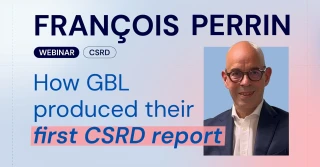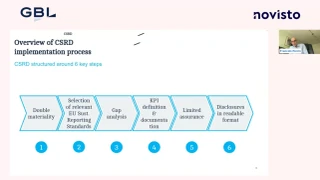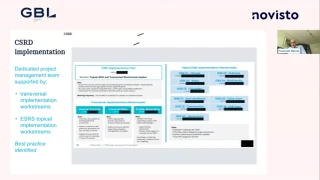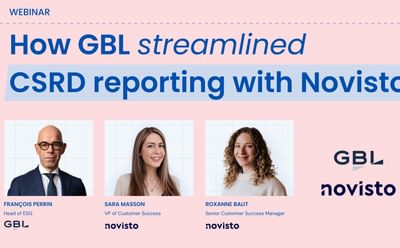
On June 4, 2025, we held a webinar with Groupe Bruxelles Lambert’s (GBL) Head of ESG, François Perrin. An established investment holding company, GBL has a long history of championing sustainability—including participation in the UN Global Compact and as a signatory to the Principles for Responsible Investment (PRI) since 2018.
In our session, François walked us through GBL’s CSRD journey, from double materiality to how they used Novisto to ensure compliance. Below, we distill his key insights and best practices for organizations preparing their first CSRD report.
Follow a structured implementation process
GBL adopted a six-step framework that began with a rigorous double materiality assessment (DMA) and culminated in a 600+ page report. Described by François as a “relatively simple and comprehensive process,” the team at GBL:
1 - Conducted a DMA
To prepare for the CSRD, GBL initiated a DMA process in 2024, first for GBL and then for each portfolio company, identifying Impacts, Risks & Opportunities (IROs). This upfront scoping determined what they would need to report on and took nine months to execute.
2 - Selected relevant ESRS
Once material topics were set, GBL proceeded to select the relevant European Sustainability Reporting Standards (ESRS). This narrowed the focus to the precise ESG metrics required by regulators.
3 - Conducted a gap analysis
This step allowed GBL to examine what they used to report on and what they’ll need to report on moving forward.
4 - Defined and documented KPIs
This entailed defining organizational-level KPIs and producing the supporting documentation needed to streamline and underpin their reporting process.
5 - Secured limited assurance
Subsequently, GBL’s auditors conducted a limited assurance review of all their KPIs and specific documentation.
6 - Delivered disclosures in a readable format
Finally, 600+ pages of disclosures were compiled in an accessible format—complete with charts and tables—to meet stakeholder needs and regulator expectations. The result was the “Delivering Meaningful Growth: Annual Report 2024 - Volume 2 Sustainability Statement,” accessible here.

Reflecting on the entire implementation process, François emphasized the importance of following each stage in the sequence, without cutting corners. “If you want to produce CSRD, you will have to go through different steps. There is no way to avoid one step or to try basically to ‘lessen’ the process and the production.”
Establish a dedicated project management team
CSRD implementation cuts across numerous functions, requiring strong project management and clear accountability at every level. GBL tackled this by splitting their project management team into two distinct units:
ESRS topic leads
Recognizing the heavy lift behind each ESRS, GBL assigned a dedicated lead to every single topic (e.g., climate or workforce)—rather than combining multiple topics.
Transversal workstreams
Beyond ESRS-specific leads, GBL formed cross-cutting streams for critical functions, namely: financial data integration, double materiality, and internal controls/auditor liaison. Clear leadership and responsibility were allocated for each stream.
Lastly, they had a dedicated CSRD implementation project manager overseeing the entire production calendar.

Implement reporting software
GBL needed a reporting platform that could consolidate disparate data and embed the internal controls required for limited assurance. Novisto’s sustainability reporting platform delivered that infrastructure, streamlining data collection, audit trails, and control checks under one roof. This setup empowered the audit committee and allowed them to confidently recommend the report for board sign-off.
“One definitive item or characteristic of Novisto that we liked was [its] ability to deliver a state-of-the-art service. So, that was really for us the key and deciding factor,” François Perrin noted. Backed by very strong customer support, an intern handled the entire rollout—configuring the platform for each consolidated entity, importing gap-analysis results, and handling day-to-day interactions, so leadership could focus on governance rather than technical details.

Advice & best practice recommendations
Reflecting on their entire CSRD implementation process, François offered specific advice about what companies can do to simplify their journey.
Risk management
The CSRD introduces new forms of risk that need to be mitigated, specifically: disclosure risk and the target risk that’s embedded in a company’s disclosure. These risk ‘types’ should be the focus of your attention throughout the CSRD process.
To manage disclosure risk, involve your audit committee at every step—this continuous oversight ensures controls are working and will give you the confidence to move forward. To address target risk, hold regular board discussions to align on the ESG targets defined during your double materiality assessment.
Role of the Chief Sustainability Officer (CSO)
Sustainability reporting is a byproduct of financial reporting and should therefore have the same governance mechanisms. As such, the Chief Sustainability Officer should involve the finance team from day one. Consequently, the CSO can act as a transformation agent, rather than a sustainability reporting manager who spends their days producing and managing data.
Role of the audit committee
The aim of the CSRD is to align non-financial requirements with financial requirements, which requires active and continuous involvement from the audit committee. According to Francois: “At the end of the day, it is the audit committee that is responsible for the supervision and the governance of the sustainability reporting under CSRD. So, make sure your audit committee is equipped with the relevant non-financial reporting skills. But also make sure that they’re involved at every stage of the process.”

How’s your CSRD journey going?
Producing your first CSRD report can feel overwhelming. But with a clear roadmap, the right team structure, and robust reporting software in place, it’s achievable. Watch the full webinar for François Perrin’s step-by-step walkthrough, including a deep dive into GBL’s double materiality assessment process.

